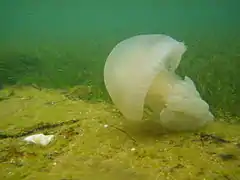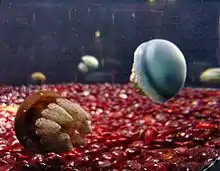Jelly blubber
The jelly blubber (Catostylus mosaicus), also known as the blue blubber jellyfish, is a species of jellyfish from coastal regions in the Indo-Pacific. It is the most commonly encountered jellyfish along the Australian eastern coast and large swarms sometimes appear in estuarine waters.
| Jelly blubber | |
|---|---|
 | |
| Jelly blubber in Port Phillip Bay, Australia | |
| Scientific classification | |
| Domain: | Eukaryota |
| Kingdom: | Animalia |
| Phylum: | Cnidaria |
| Class: | Scyphozoa |
| Order: | Rhizostomeae |
| Family: | Catostylidae |
| Genus: | Catostylus |
| Species: | C. mosaicus |
| Binomial name | |
| Catostylus mosaicus Quoy & Gaimard, 1824 | |
Description

In Sydney waters, the jelly blubber's large bell is a creamy white or brown colour, but farther north in Australia it is usually blue.[1] The colours are derived from symbiotic algal plant cells within the body of the jellyfish.[2][3] There is no obvious mouth on the underside, but there are small openings on each arm, through which food is passed to the stomach.[4] The tentacles also have stinging cells that can capture tiny crustaceans and other plankton. It can grow up to 35cm across.[2]
The sting can be painful but generally poses no serious risk to humans.

Distribution and habitat
This jellyfish is found in coastal parts of the Indo-Pacific. In Australia, it occurs off the coasts of Queensland, New South Wales and Victoria. It can also enter intertidal estuaries.[5]
Food
Eats mainly plankton, small fish, some crustaceans, and small particles in the ocean water.
References
- "Catostylus mosaicus". Julian Rocks. Archived from the original on 2010-06-25.
- "Blue Blubber". www.qm.qld.gov.au. Retrieved 2022-05-08.
- "Jelly Blubber". The Australian Museum. 14 October 2020. Retrieved 8 May 2022.
- "Blubber jelly". Monterey Bay Aquarium. Retrieved 2014-04-07.
- "Catostylus mosaicus (Quoy & Gaimard)". World Register of Marine Species. Retrieved 2014-02-14.